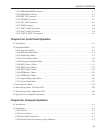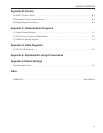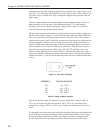
1-2
Chapter 1, INTRODUCTION
Appendix D
Shows the connection diagrams for suitable RS232 null-modem cables to couple the
unit to an IBM-PC or 100 % compatible computer.
Appendix E
Gives an alphabetical listing of the computer commands for easy reference.
Appendix F
Provides a listing of the instrument settings produced by using the default setting
function.
If you are a new user, it is suggested that you unpack the instrument and carry out the
procedure in chapter 2 to check that it is working satisfactorily. You should then make
yourself familiar with the information in chapters 3, 4 and 5, even if you intend that
the unit will eventually be used under computer control. Only when you are fully
conversant with operation from the front panel should you then turn to chapter 6 for
information on how to use the instrument remotely. Once you are familiar with the
structure of the computer commands, appendix E will prove to be convenient as it
provides a complete alphabetical listing of these commands in a single easy-to-use
section.
1.2 What is a Lock-in Amplifier?
In its most basic form the lock-in amplifier is an instrument with dual capability. On
the one hand it can recover signals in the presence of an overwhelming noise
background or alternatively it can provide high resolution measurements of relatively
clean signals over several orders of magnitude and frequency.
Modern instruments, such as the model 7220, offer far more than these two basic
characteristics and it is this increased capability which has led to their acceptance in
many fields of scientific research, such as optics, electrochemistry, materials science,
fundamental physics and electrical engineering, as units which can provide the
optimum solution to a large range of measurement problems.
The model 7220 lock-in amplifier can function as a:-
n AC Signal Recovery Instrument n Transient Recorder
n Vector Voltmeter n Precision Oscillator
n Phase Meter n Frequency Meter
n Spectrum Analyzer n Noise Measurement Unit
These characteristics, all available in a single compact unit, make it an invaluable
addition to any laboratory.


















